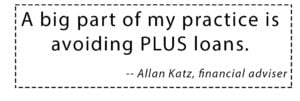
Parent PLUS College Loans Can Spell Peril
 A dramatic increase in 1993 in how much parents are permitted to borrow from the federal government for their children’s college is coming home to roost.
A dramatic increase in 1993 in how much parents are permitted to borrow from the federal government for their children’s college is coming home to roost.
Since then, average debt through the parent PLUS loans has more than tripled, adjusted for inflation, according to a Brookings Institution report. About one in 10 parents owe more than $100,000. And as loan balances have ballooned, the rate of repayment has slowed.
Now that the college applications have been submitted, Allan Katz, a financial adviser in Staten Island, New York, has this advice for parents contemplating their next move:
PLUS loans should be avoided “at all cost,” he said. “A big part of my practice is avoiding PLUS loans.”
His dire warning stems from the 1993 change in the law, which made it easier for parents to get into trouble. The reform increased how much parents can borrow from $4,000 per year to whatever the teenager needs to cover his or her school expenses – regardless of the institution’s cost. Total borrowing per child used to be capped at $20,000 – there is no limit today.
College is a top priority, and many parents don’t have options other than the federal PLUS loans. But the removal of the borrowing limit combined with rising tuitions have left more parents “saddled with large debt burdens, ultimately repaying just enough to avoid default and sometimes owing significantly more than their initial balance,” the Brookings report said.
PLUS loans permit parents to borrow the total cost of college – tuition, room and board, books, and lab fees – minus any grants and loans the university provides to the student. Assume a conservative $31,000 a year for total college costs. Suppose the student receives $7,000 annually from the university and borrows the maximum for federal Stafford loans every year. This leaves the parents with $70,000 in PLUS loans after four years of college.
But they can easily be in debt for much more, to the point that the payments feel like a second mortgage. First, the interest rate on PLUS loans is a steep 7.6 percent. Second, the compound interest is much higher for parents who take advantage of a different provision in the 1993 legislation that lets them opt to defer their loan payments until after graduation.
An alternative to PLUS loans is a home equity line of credit, which charges rates of 3 percent to 4 percent. “Take it out as you need it, rather than all at once,” Katz said. And pay it down whenever possible.
He said these steps will save money. For parents paying for college and worrying about retirement, every little bit helps.
Squared Away writer Kim Blanton invites you to follow us on Twitter @SquaredAwayBC. To stay current on our blog, please join our free email list. You’ll receive just one email each week – with links to the two new posts for that week – when you sign up here. This blog is supported by the Center for Retirement Research at Boston College.
Comments are closed.







There was just a piece in The Atlantic referencing research around the Jack Kent Cooke Foundation’s Undergraduate Transfer Scholarship program and documenting the academic success of students who’d transferred from community colleges to elite universities. Affordability should always be a top consideration when choosing a college.
HELOC for college loans? Thought you could only use HELOC for home renovations?
HELOCs are structured so your home is your collateral with the loaned amount to be used however you want. I’ve used it several times for vehicle purchases. Just understand that if you default on the repayment your home is at risk of being sold to make the lender whole.
Hmm…Recently read an article on this: I believe that now, with so-called tax “reform,” the interest paid on a HELOC is no longer deductible if it’s used for things other than straight, visible home improvements. Correct me if I’m wrong — but it seems to have been diminished in attractiveness for college-financing through this odd, new tax system…
Between 1985 & 2001, the average tuition nationwide increased 498% (4 times inflation)! This far exceeds the PLUS loan utilization rate increase mentioned above. Government-sponsored and uncapped PLUS loans have created a perverse incentive for colleges to increase tuition exponentially. If tuition increases were capped, schools would have reason to create affordable options like programs for working students or flexible attendance. Such programs would benefit poorer families and single mothers. Colleges now view student loans as a government subsidy to expand their mission without regard to cost. Unfortunately, families are bearing the burden of not only the cost of their tuition but also unrestrained spending by university administrators. We can only imagine the profligate inflation in costs that would occur if government-subsidized “free tuition” is actually attempted. If such unlimited costs were shifted from students to taxpayers, the availability of a college education would inevitably shrink. A quality university education would become an insanely expensive and finite commodity unavailable to most citizens as it is in Europe. There are only two possible outcomes to avoid such an eroding of the U.S. higher education system: 1. capping annual tuition increases to a standard rate of inflation, or 2. eliminate government subsidies (loans) entirely from the equation. Either proposal would force schools to create affordable options.
Have you visited a college campus any time recently? Shiny new buildings, luxurious dormitories, gyms with Olympic size pools and rock climbing walls; at one college there is a fabulous new library, but if you want to take out books, you order them and they’re ready in 24 hours, because the library is a place with stunning meeting places and media centers.
Students and parents are going into debt up to their eyeballs for all this.